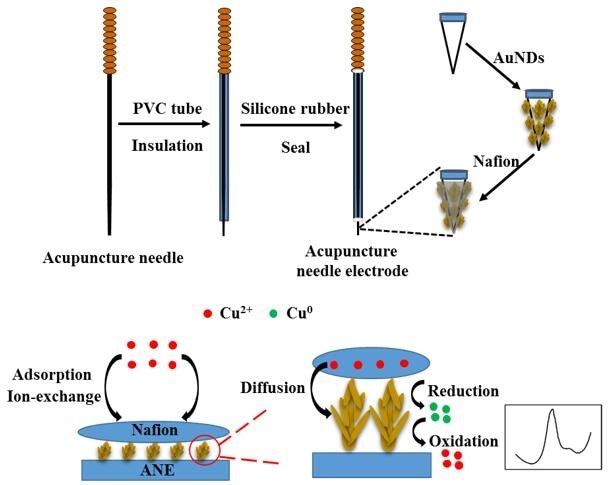Apr 22 2019
Seawater contains trace heavy metals that are toxic pollutants both to the ecological environment and to human health. The toxicity of heavy metals is not associated with their total concentration, but rather to their prevalent forms in seawater environment.
 Fabrication of the needle sensor and detection mechanism for Cu by ASV. (Image credit: YIC)
Fabrication of the needle sensor and detection mechanism for Cu by ASV. (Image credit: YIC)
For the speciation analysis of metal elements, anodic stripping voltammetry, or ASV, offers the most simple and effective method. Owing to the limitation of the sensitivity of sensors, there is a need for innovative sensors that come with high sensitivity to enable speciation examination of trace active heavy metals present in seawater.
Now, a research team from the Yantai Institute of Coastal Zone Research (YIC), Chinese Academy of Sciences (CAS), has created a novel needle-shaped sensor that is predicated on the stainless steel acupuncture needle, through the insulation, sealing, and functionalization processes.
The needle sensor effectively established the active heavy metals (copper as template) in seawater. The innovative needle—due to the size of needle electrode, the unique morphology, and the enrichment performance and electrochemical catalysis of functional nanomaterials—showed exceptional performance as well as ultra-high sensitivity (15.4 pM detection limit) for copper detection through the ASV technique.
Through diverse sample pretreatment processes, the determination of three varied forms of copper—dissolved acid extractable, dissolved active, and total acid extractable—in seawater was achieved by utilizing the needle sensor with the ASV technique.
As a better construction technique of needle sensor, self-assembly approach was employed to alter the acupuncture needle surface with functional nanomaterials, thus rendering the sensor more stable. Based on the stainless steel acupuncture needle, the new needle sensor exhibited the benefits of puncture ability, high hardness, and convenient integration of sensors.
The pertinent studies, reported in Electrochimica Acta and Analytic Methods, respectively, were supported by the Youth Innovation Promotion Association of CAS, the Key Research and Development Plan of Shandong Province and Yantai City.